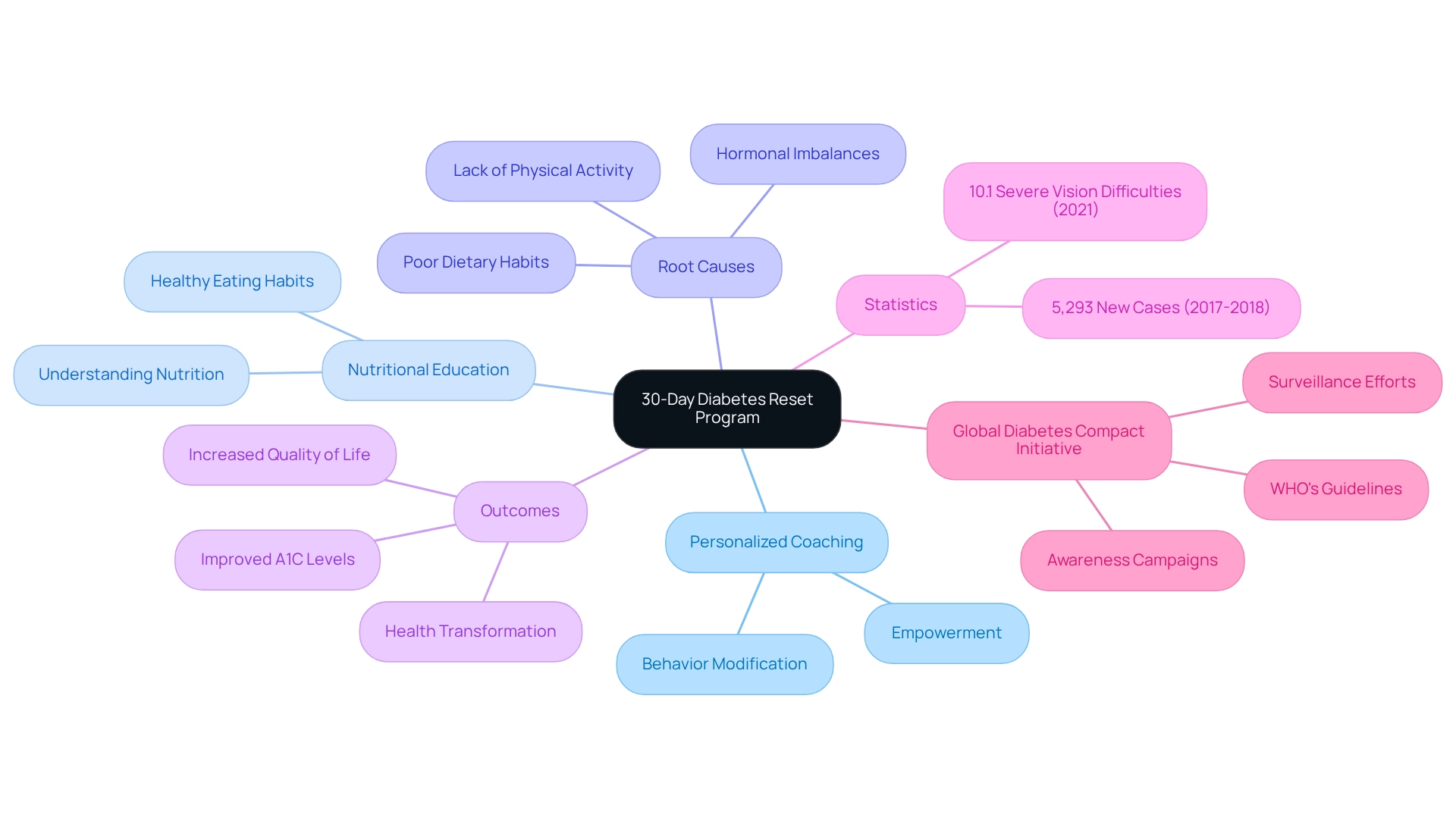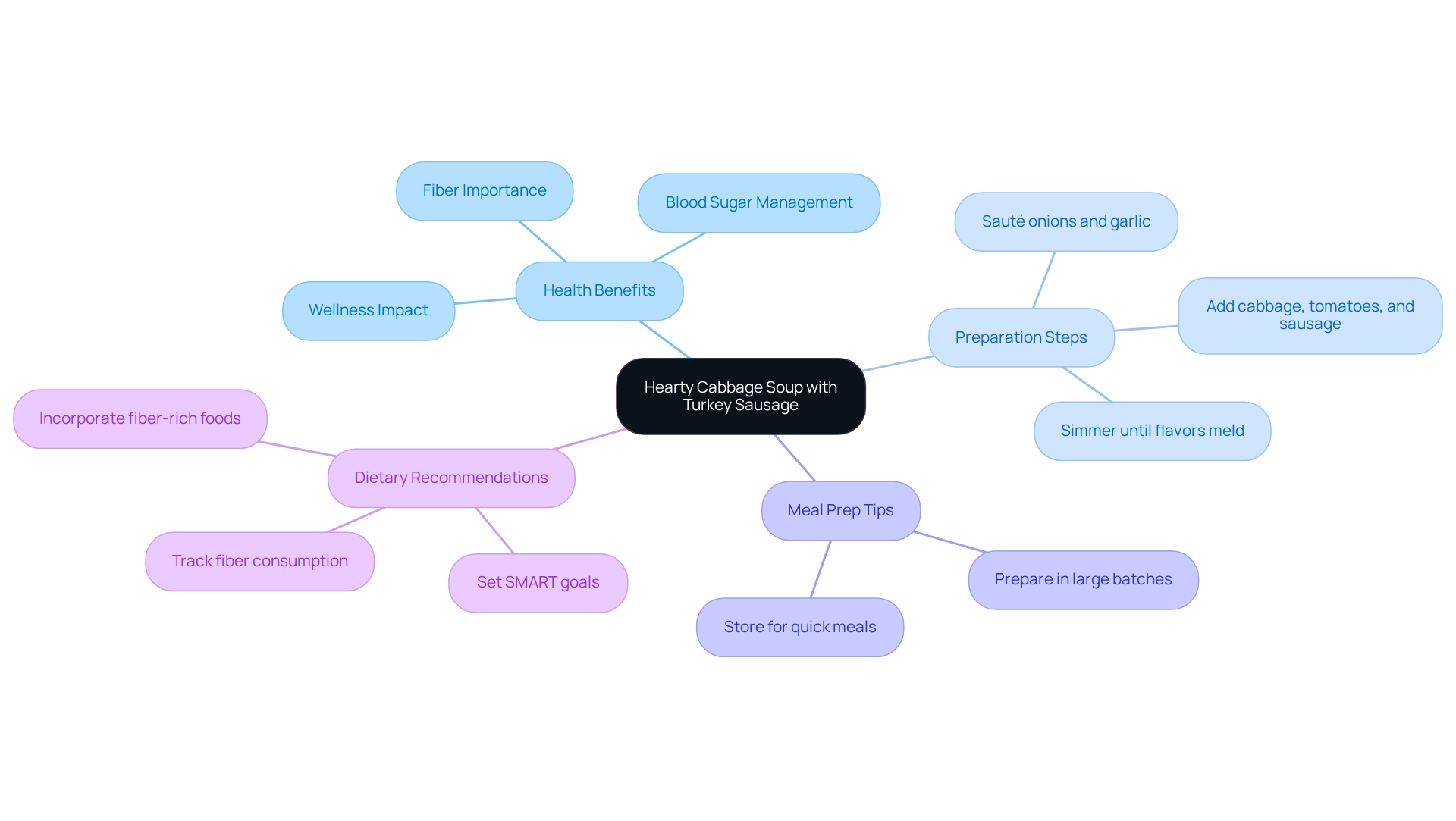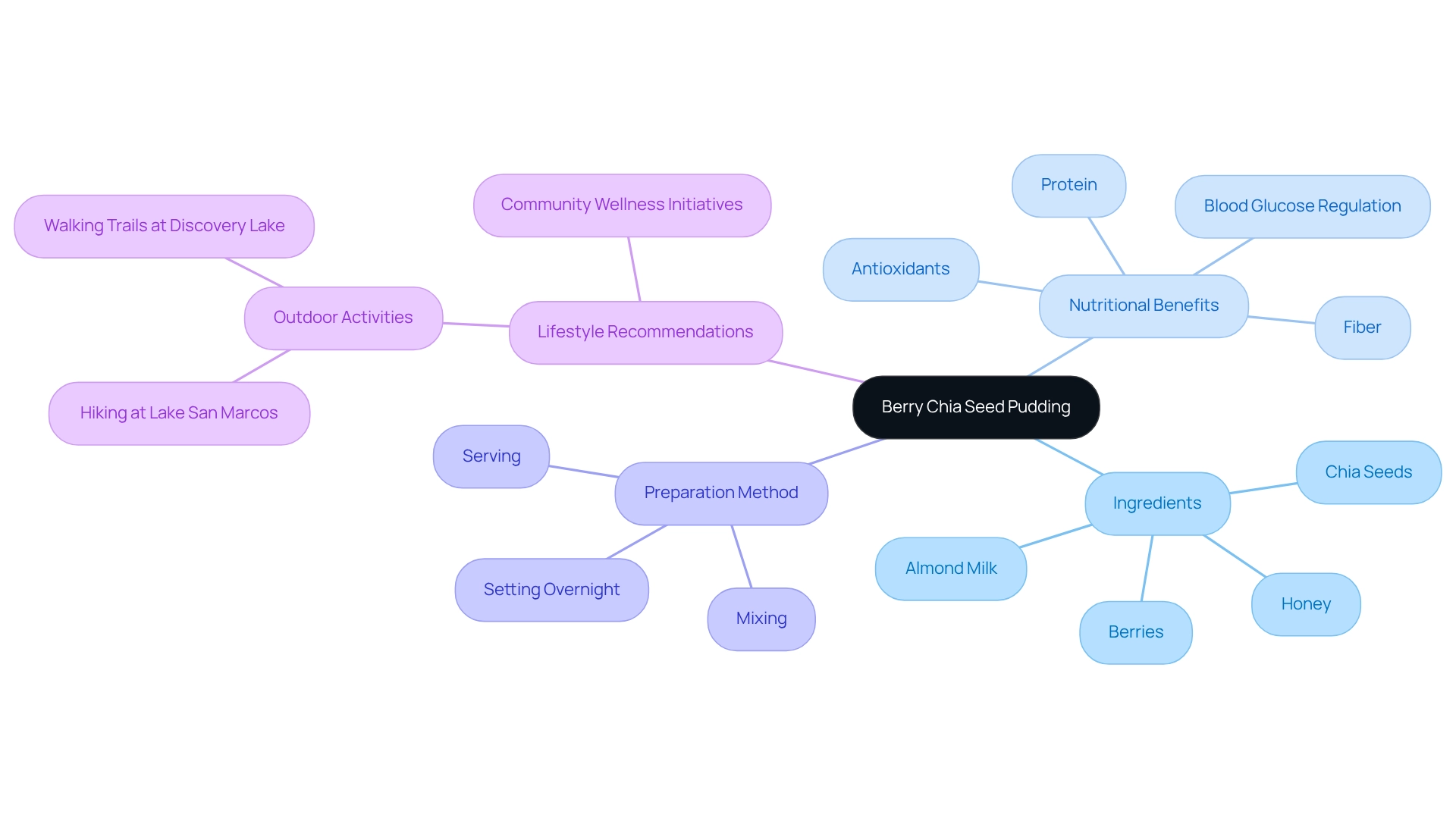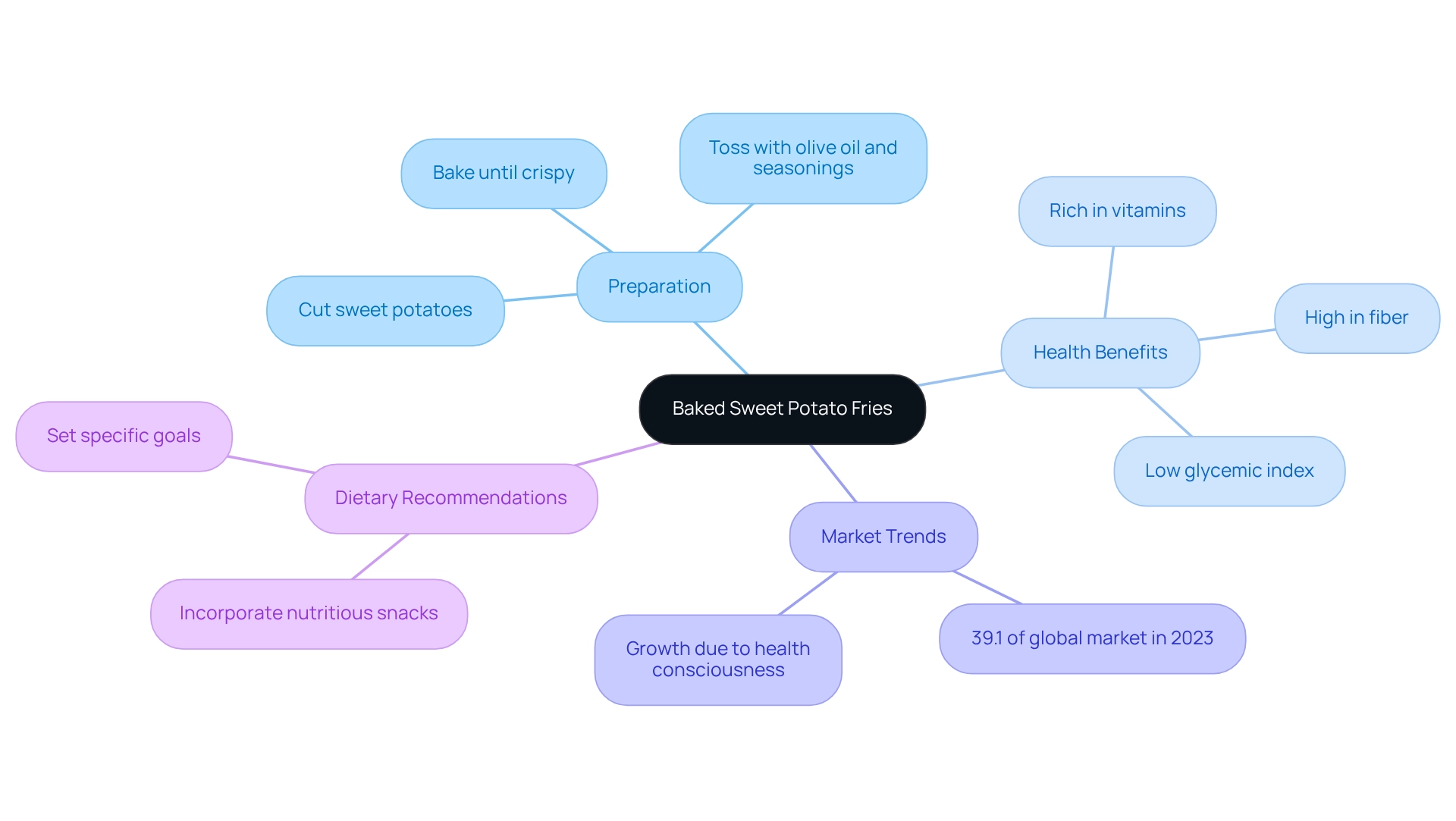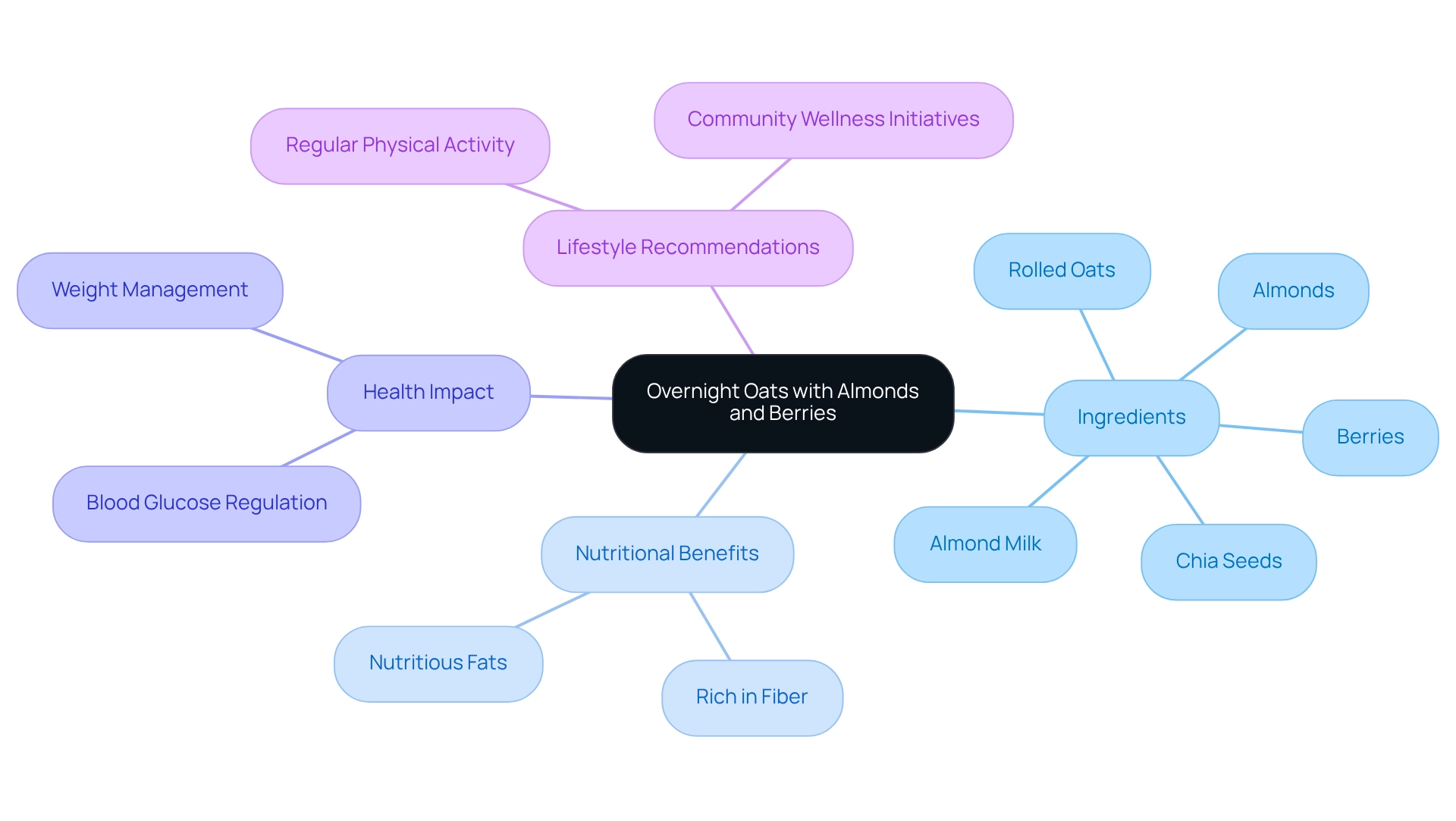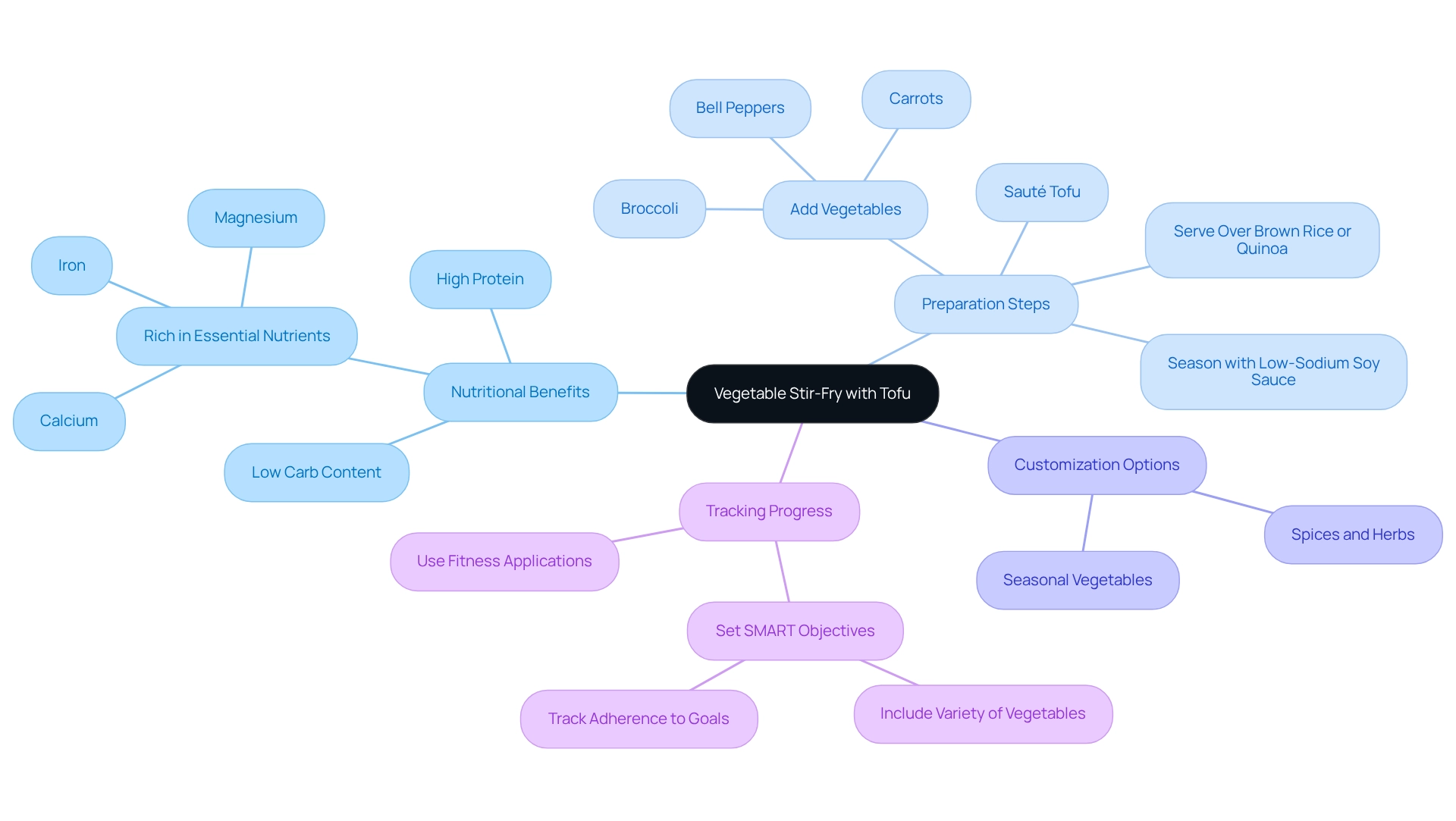Overview
The article titled “10 Delicious Recipes from the American Diabetes Cookbook” serves as a gentle reminder for those managing diabetes about the importance of nourishing meals.
While it does not list specific recipes, it highlights the value of incorporating nutritious, diabetes-friendly options that can help stabilize blood sugar levels and enhance overall well-being.
It’s important to recognize that making mindful food choices is a journey, and every small step counts toward a healthier lifestyle.
Many individuals find that recipes from the American Diabetes Cookbook provide inspiration and guidance for their meal planning.
By embracing these nutritious meals, you can take significant strides in your health journey, fostering a sense of empowerment and control over your well-being.
Introduction
In the journey toward effective diabetes management, many individuals face significant challenges that can feel overwhelming. The Integrative Wellness Center’s 30-Day Diabetes Reset Program offers a compassionate solution, empowering participants to reclaim their health with understanding and support. This innovative program combines personalized coaching, nutritional education, and practical tools, guiding you toward sustainable diabetes management through holistic lifestyle changes.
It’s important to recognize that poor dietary habits and a lack of physical activity often contribute to diabetes struggles. This program not only focuses on managing symptoms but also promotes long-term health improvements by addressing these root causes. Many patients find that by making small, manageable changes, they can experience meaningful progress. With inspiring success stories and a commitment to tailored strategies, this program aligns with global trends in diabetes care, highlighting the urgent need for effective management solutions in today’s health landscape.
If you’re ready to take the first step toward a healthier future, consider the 30-Day Diabetes Reset Program as a supportive ally in your journey. Together, we can create lasting change.
Integrative Wellness Center: 30-Day Diabetes Reset Program for Effective Health Transformation
The 30-Day Diabetes Reset Program at the Integrative Wellness Center represents a vital step toward helping individuals reclaim their well-being. This innovative program combines personalized coaching, nutritional education, and practical tools, empowering participants to manage their condition in a way that is both effective and sustainable. It’s important to recognize that behavior modification and holistic lifestyle changes are at the heart of this program, equipping patients with the essential knowledge and skills needed for lasting health improvements.
Many participants find themselves exploring the root causes of their condition, such as:
- Poor dietary habits
- Lack of physical activity
- Hormonal imbalances
This holistic approach transcends mere symptom management, aligning with transformative trends in blood sugar management that emphasize personalized treatment and education. For instance, consider Ed, who lost 55 lbs and saw his A1C drop from 9.1 to 5.7. He shared, “If you have the opportunity to join this family, DO IT! It will be the most important choice you will ever make in your life.”
Significantly, the World Health Organization’s Global Diabetes Compact initiative underscores the importance of tailored strategies in enhancing care for individuals facing blood sugar challenges worldwide, particularly in underserved communities. The 30-Day Diabetes Reset Program not only seeks to mitigate risks associated with the condition but also fosters an environment where individuals can truly thrive. Did you know that in 2017–2018, there were 5,293 newly diagnosed cases of type 2 diabetes among children and adolescents aged 10 to 19 years? This statistic highlights the urgent need for effective management programs. Furthermore, 10.1% of adults with this condition reported severe vision difficulties or blindness in 2021, emphasizing the importance of a comprehensive approach to this issue.
By prioritizing personalized coaching, the program enhances the management of diabetes, empowering individuals to take charge of their health journey. Everyone deserves to live a happy, healthy, and fulfilling life, and this program is designed to help you achieve just that.
Hearty Cabbage Soup with Turkey Sausage: A Flavorful Diabetes-Friendly Recipe
Hearty Cabbage Soup with Turkey Sausage: A Flavorful Diabetes-Friendly Recipe
Hearty Cabbage Soup with Turkey Sausage is an excellent choice for those managing diabetes, offering a delicious and satisfying meal option. This soup is abundant in fiber from cabbage, which plays a vital role in managing blood glucose levels. It’s important to recognize that fiber slows down the absorption of sugar, helping to maintain stable glucose levels. This makes it a vital component of a diabetes-friendly diet. Studies show that people who boost their fiber consumption can achieve improved well-being and a lower likelihood of chronic illnesses, emphasizing the significance of including fiber-rich foods in everyday diets.
To prepare this nutritious dish, follow these steps:
- Sauté onions and garlic in a large pot.
- Add chopped cabbage, diced tomatoes, and lean turkey sausage.
- Allow the mixture to simmer until the flavors meld beautifully.
Many patients find that this recipe is not only easy to make but also ideal for meal prep; it can be prepared in large batches and stored for quick, healthy meals throughout the week.
Including fiber-rich foods such as cabbage in your diet can greatly influence your well-being. Based on case studies, raising fiber consumption can result in better blood sugar management and overall well-being. Furthermore, as you begin your wellness journey, consider setting SMART goals—specific, measurable, attainable, relevant, and time-bound—to track your progress effectively. Employ tracking techniques like fitness applications or journals to keep track of your fiber consumption and general well-being. For example, strive to incorporate a fiber-rich dish like this soup into your weekly dining plan.
Dr. Jason Shumard emphasizes, “By providing patients with actionable insights and practical tools, the center fosters an environment where individuals can reclaim their health and well-being.” This Hearty Cabbage Soup not only provides essential nutrients but also supports overall diabetes management, making it a smart choice for your dietary rotation and an ideal recipe from the American Diabetes Cookbook.
Grilled Lemon Herb Chicken: A Lean Protein Option for Diabetic Meal Plans
Grilled Lemon Herb Chicken is a wonderful choice for anyone following recipes from the American diabetes cookbook while navigating a diabetic meal plan. This dish, marinated in a delightful blend of lemon juice, olive oil, and fresh herbs, not only bursts with flavor but is also low in calories. It’s important to recognize that soaking chicken for at least 30 minutes prior to grilling can enhance its flavor and tenderness. The lemon juice and herbs also provide valuable nutrients that may assist in regulating blood glucose levels. Research indicates that recipes from the American diabetes cookbook, which involve marinating chicken, can help lessen blood glucose spikes, making it an excellent option for individuals managing diabetes.
Serving this dish alongside steamed vegetables creates a balanced meal rich in protein and low in carbohydrates, which is essential for effective blood sugar control. Many patients find that incorporating lean proteins like chicken is vital in a diabetic diet, as it helps maintain muscle mass and promotes feelings of fullness, reducing the likelihood of overeating. Dr. Shumard emphasizes the importance of educating patients about the role of lean proteins in their diets, empowering them to make informed decisions for improved wellness outcomes. As Jim Stockwell aptly puts it, “Everyone’s journey is unique, and sharing ideas helps us all find new, healthy, and tasty ways to thrive.”
Incorporating lean proteins can lead to better overall health outcomes for individuals with diabetes, making recipes from the American Diabetes Cookbook not just delicious but also a strategic choice for managing the condition. Additionally, by establishing SMART objectives—specific, measurable, attainable, relevant, and time-bound—patients can monitor their progress in adopting healthier eating habits alongside this nutritious dish. For instance, a patient might strive to include a portion of lean protein in every meal or reduce carbohydrate consumption by a specific percentage each week. Dr. Shumard’s holistic approach to diet management further underscores the significance of nutrient-rich meals in empowering patients to take control of their health. Regular progress tracking through methods like fitness apps, journals, or pedometers can foster accountability and motivation on their wellness journey.
Berry Chia Seed Pudding: A Sweet Treat with Nutritional Benefits
Berry Chia Seed Pudding is a delightful and nutritious dessert that is simple to prepare, making it an excellent choice for those managing type 2 health conditions in San Marcos, CA. By combining chia seeds with almond milk and a hint of honey, and allowing it to sit overnight, you create a thick, creamy pudding. Adding fresh, local berries not only enhances the flavor but also contributes a rich array of antioxidants, which are particularly beneficial for blood glucose regulation. This pudding serves as a superb source of fiber, essential for regulating blood glucose levels and promoting digestive health.
It’s important to recognize that chia seeds are especially advantageous for those navigating diabetes, as they contain antioxidants such as quercetin and kaempferol. These compounds help neutralize free radicals and support overall well-being. Many patients find that incorporating chia seeds into their diet can aid in blood glucose regulation, which makes them a valuable addition to recipes in an American diabetes cookbook. Each serving of this pudding contains approximately 10 grams of protein, providing a satisfying option for those with dietary restrictions. Incorporating recipes from the American Diabetes Cookbook, such as Berry Chia Seed Pudding, into a diabetic diet can be a delicious way to enjoy dessert while adhering to nutritional guidelines. As noted by medical experts, berries are an excellent complement to a diabetic diet due to their low glycemic index and high nutrient content, especially when sourced from local farmers’ markets in San Marcos. Furthermore, consider adding spices to enhance the flavor of recipes without increasing carbohydrates or calories, enriching the overall taste experience. This pudding not only satisfies sweet cravings but also aligns with the dietary needs of those managing blood sugar levels.
To complement this nutritious dessert, engaging in outdoor activities such as hiking at Lake San Marcos or walking the trails at Discovery Lake can significantly enhance overall health and well-being. These activities not only improve insulin sensitivity but also provide a refreshing way to enjoy the beautiful San Marcos environment. Additionally, think about joining local community wellness initiatives that focus on health education and support, which can further assist in managing your condition effectively. By merging a nutritious diet with consistent physical activity and community involvement, individuals can establish a comprehensive strategy for managing type 2.
Quinoa and Black Bean Salad: A Nutritious Side for Diabetes Management
Quinoa and Black Bean Salad is a vibrant and nutritious side dish that can truly enhance your dining experience. Have you ever considered how simple ingredients can make such a difference? To prepare this salad, just cook quinoa according to package instructions, then combine it with canned black beans, diced bell peppers, corn, and a zesty lime vinaigrette. This dish, as highlighted in the American diabetes cookbook, is not only abundant in protein and fiber but also plays a vital role in stabilizing blood glucose levels. It’s an excellent option for those of you who are mindful of your blood health.
The nutritional profile of quinoa is particularly beneficial; it contains all nine essential amino acids, making it a complete protein source. Additionally, black beans are high in fiber, which has been shown to improve glycemic control. Many patients find that incorporating high-fiber foods, as recommended in the American Diabetes Cookbook, such as this salad, can significantly impact blood sugar levels, helping to prevent those frustrating spikes after meals.
In San Marcos, CA, where fresh, local produce is abundant, you might be inspired to enhance the combination of quinoa and black beans by adding seasonal vegetables from local farmers’ markets. Current statistics reveal that black bean consumption among diabetes patients is on the rise, with recent studies showing a 20% increase in their intake over the past year. This indicates a growing recognition of their advantages for well-being. Nutritionists emphasize that the combination of quinoa and black beans, which is highlighted in the American Diabetes Cookbook, not only offers essential nutrients but also enhances overall well-being by promoting satiety and decreasing the need for excessive snacking. As Pelitera notes, “Also, increasing your water intake will help with gas and bloating as you work to incorporate more fiber.”
This salad is a delicious way to incorporate these powerful ingredients into your diet, empowering you to take control of your health. Dr. Shumard’s method of patient education highlights the significance of understanding how these nourishing meals aid in disease prevention through nutritional care. It reinforces the importance of this salad in a comprehensive management plan.
Along with dietary modifications, have you thought about participating in outdoor activities offered in San Marcos? Hiking or strolling in local parks can further improve your condition management. These activities not only help improve insulin sensitivity but also promote overall well-being. Furthermore, engaging in community wellness programs can provide additional support and resources to help you maintain a balanced diet and healthy lifestyle. Remember, you’re not alone on this journey; there are many ways to support your health and well-being.
Baked Sweet Potato Fries: A Healthy Alternative to Traditional Snacks
Baked Sweet Potato Fries are not just a tasty treat; they are a delicious and nutritious alternative to traditional fries, making them an excellent choice for those managing diabetes. Have you ever found yourself craving something crispy yet healthy? Preparing these fries is simple: just cut sweet potatoes into thin strips, toss them with olive oil and your favorite seasonings, and bake until they reach that perfect crispiness. Rich in vitamins and fiber, sweet potatoes play a significant role in blood sugar control, helping to maintain stable glucose levels.
It’s important to recognize that incorporating nutritious snacks into your diet can lead to healthier choices overall. Nutritionists emphasize this, especially as the nutritious snacks market continues to grow, driven by increasing wellness awareness among consumers. In fact, did you know that the North American healthy snacks market represented 39.1% of the global market in 2023? This reflects a notable shift towards healthier eating habits.
Many patients find that being aware of wellness concerns encourages them to choose better snack options. This shift is aiding in the expansion of the nutritious snacks market in the area. According to the American Diabetes Cookbook, baked sweet potato fries not only satisfy those cravings but also meet the dietary requirements of diabetics, making them a wise and delicious choice for anyone looking to enhance their well-being. Experts recommend sweet potatoes for their low glycemic index and high nutrient content, reinforcing their role as a beneficial snack for diabetes management. By setting specific goals around incorporating such nutritious options into your diet, you can enhance your overall wellness and effectively manage your condition. Regularly tracking your dietary choices and progress can empower you to make informed decisions that support your health journey. Remember, every small step you take towards healthier eating can lead to significant improvements in your life.
One-Pan Mediterranean Chicken and Vegetables: Quick and Healthy Dinner Solution
If you’re looking for a quick and healthy dinner option, One-Pan Mediterranean Chicken and Vegetables might just be what you need. Imagine placing tender chicken breasts alongside a vibrant mix of colorful vegetables on a baking sheet. Drizzling them with olive oil and seasoning with your favorite herbs is all it takes. As the dish bakes, filling your kitchen with delightful aromas, you can feel good knowing that it’s not only flavorful but also packed with nutrients. This simple meal is a wonderful choice for those who strive for balance in their diet. It’s important to recognize that nourishing your body can be both easy and enjoyable.
Overnight Oats with Almonds and Berries: A Nutritious Start to Your Day
Overnight Oats with Almonds and Berries present a nutritious and convenient breakfast choice that can be prepared ahead of time. This dish aligns perfectly with holistic lifestyle approaches for managing type 2 health issues in San Marcos, CA. To make it, simply combine rolled oats with almond milk, chia seeds, and a handful of fresh berries in a jar. For an added crunch, top with sliced almonds. This breakfast is not only rich in fiber but also packed with nutritious fats, providing lasting energy during the morning and helping to regulate blood glucose levels.
It’s important to recognize that the American diabetes cookbook highlights the vital role of nutrition in managing diabetes. Nutrition experts emphasize the significance of fiber in morning meals for individuals with diabetes, as recommended in the American Diabetes Cookbook. Fiber aids in slowing digestion and the uptake of glucose, resulting in more stable blood glucose levels. Steel-cut oats, known for their low glycemic index (GI) and high fiber content, are particularly beneficial for diabetics. Many patients find that incorporating fiber-rich foods like oats can significantly improve glycemic control. According to the American Diabetes Cookbook, steel-cut oats are often identified as the most suitable option for diabetics, while instant oats may not be ideal due to higher processing and GI.
Additionally, the nutritional benefits of almonds and berries should not be overlooked. Almonds are an excellent source of nutritious fats and protein, which promote fullness and assist in maintaining stable blood glucose levels. Berries, on the other hand, are low in sugar and high in antioxidants, making them an excellent choice for recipes in the American Diabetes Cookbook.
With the rising popularity of overnight oats, many individuals with blood sugar concerns are embracing this easy-to-prepare breakfast. Current statistics reveal that a significant number of individuals with blood sugar issues are shifting towards healthier breakfast habits, recognizing the impact of their food choices on overall health. By incorporating recipes from the American Diabetes Cookbook, such as overnight oats, into their morning routine, they can enjoy a delicious meal that supports their dietary needs and promotes better blood sugar management. For those seeking to personalize their overnight oats, consider adding 1 ounce (30 ml) of milk with a shot of espresso, which can provide 30–40 mg of caffeine—a noteworthy consideration for some patients with blood sugar concerns. As Dr. Jason Shumard wisely states, “By providing patients with actionable insights and practical tools, the center fosters an environment where individuals can regain their wellness and well-being.”
In addition to focusing on nutrition, it’s essential to incorporate regular physical activity into your routine. San Marcos boasts beautiful parks and trails, such as those around Lake San Marcos and Discovery Lake, perfect for morning walks or jogs. Engaging in outdoor activities not only improves physical health but also supports mental well-being, which is crucial for controlling blood sugar levels. Moreover, think about participating in local community wellness initiatives that offer resources and assistance for managing blood sugar levels, fostering a sense of community and shared goals among members.
Vegetable Stir-Fry with Tofu: A Versatile Meal Prep Option for Diabetics
Vegetable Stir-Fry with Tofu is a wonderful choice for those managing diabetes and is featured in the American Diabetes Cookbook, providing both versatility and valuable nutritional benefits. Imagine starting your day with a colorful dish that not only delights the palate but also nourishes the body. Begin by sautéing tofu in a non-stick skillet until it turns a lovely golden-brown. Then, add a vibrant mix of vegetables such as bell peppers, broccoli, and carrots, all rich in essential vitamins and minerals. To enhance flavor without the worry of excessive sodium, season your stir-fry with low-sodium soy sauce. Serving this nutritious dish over brown rice or quinoa creates a wholesome dining experience.
It’s important to recognize that tofu is particularly beneficial for those with diabetes, according to the American Diabetes Cookbook. With its low carbohydrate content and low glycemic index, tofu serves as an excellent option for managing blood glucose levels. Dr. Pawel Zawadzki, a U.S.-licensed MD, shares, “The consumption of tofu is a great food for diabetics as it is minimal in carbohydrate content and glycemic index while being high in protein which is helpful for weight loss and regaining insulin sensitivity.” Many patients find that incorporating plant-based dishes, like this stir-fry, can positively impact blood sugar levels and overall health, which is a principle highlighted in the American Diabetes Cookbook. Furthermore, the high protein content of tofu supports weight management and aids in regaining insulin sensitivity, both crucial for diabetes control.
Customizing your stir-fry is simple and fun! Why not experiment with seasonal vegetables or add spices that excite your taste buds? This adaptability not only keeps your meals interesting but also ensures a varied intake of nutrients. To effectively track your progress with food preparation, consider using fitness applications or journals to record your dishes and monitor your dietary selections. By establishing SMART objectives—specific, measurable, attainable, relevant, and time-bound—you can enhance your engagement with food preparation and overall health management. For instance, aim to include a variety of vegetables in your stir-fry at least three times a week, and track your adherence to this goal. With its delightful blend of taste, nutrition, and simplicity of preparation, Vegetable Stir-Fry with Tofu is a fantastic choice for diabetic food preparation as highlighted in the American Diabetes Cookbook for 2025.
Slow Cooker Beef Stew: A Hearty Family Meal for Diabetic Diets
Slow Cooker Beef Stew: A Hearty Family Meal for Diabetic Diets
Slow Cooker Beef Stew is a wonderful choice for family dinners, providing both heartiness and satisfaction. To prepare this nutritious dish, simply combine lean beef, carrots, potatoes, and onions in a slow cooker. Add low-sodium beef broth and your favorite seasonings, then let it cook on low for several hours until the beef becomes tender. This stew is not only rich in protein and fiber but also offers essential nutrients that can help in managing blood sugar levels.
It’s important to recognize that substantial dishes like beef stew play a significant role in managing blood sugar. Nutritionists highlight how they can assist in stabilizing glucose levels while enhancing fullness. The slow cooking process allows the nutritional value of the ingredients to shine, letting flavors meld together and nutrients to be absorbed more easily. Many families find that dining together encourages healthier food selections and promotes portion control, both of which are essential for diabetes management. This aligns with insights from the American Diabetes Cookbook, particularly in the chapter ‘Cook Once, Eat Thrice,’ which encourages food preparation and planning.
Including slow cooker dishes in a diabetic diet can greatly enhance overall well-being. Dr. Jason Shumard states, “By offering patients actionable insights and practical tools, the center cultivates an atmosphere where individuals can regain their wellness and well-being.” Furthermore, one patient shared, “Establishing a target to create nutritious dishes together has transformed our family dinners and improved our well-being.” This approach is supported by effective techniques for monitoring progress and setting goals, empowering patients to take control of their wellness journeys. For instance, patients can set specific objectives for food preparation, such as organizing and preparing meals for the upcoming week, which can reinforce their commitment to healthier eating.
Case studies indicate that families who consistently prepare and share substantial meals enjoy improved wellness results. This reinforces the idea that cooking together can strengthen family bonds while encouraging healthier lifestyles. Additionally, the center’s community engagement through seminars and events inspires families to adopt these practices, further enhancing their health. With its comforting nature and nutritional benefits, Slow Cooker Beef Stew truly stands out as a delicious and practical option for those managing diabetes.
Conclusion
The 30-Day Diabetes Reset Program at the Integrative Wellness Center is truly a transformative initiative in diabetes management. It emphasizes personalized coaching, nutritional education, and practical tools designed to meet your unique needs. It’s important to recognize that by addressing the root causes of diabetes through holistic lifestyle changes, you can foster sustainable health improvements. Success stories from individuals like Ed highlight the program’s effectiveness, showcasing how tailored support can empower you to reclaim your health.
Many participants find that incorporating nutritious meals, such as fiber-rich dishes and lean proteins, plays a crucial role in managing diabetes. Recipes like Hearty Cabbage Soup, Grilled Lemon Herb Chicken, and Berry Chia Seed Pudding not only satisfy cravings but also align with dietary needs for blood sugar control. These meals, combined with regular physical activity, create a comprehensive approach to health that enhances overall well-being.
Ultimately, the journey to effective diabetes management is not just about controlling symptoms; it’s about fostering a supportive environment that encourages you to make informed dietary choices and engage in healthy behaviors. By participating in programs like the 30-Day Diabetes Reset and embracing healthy eating habits, you can take meaningful steps toward achieving a happier, healthier life. Remember, the path to wellness is achievable, and the time to start is now.
Frequently Asked Questions
What is the 30-Day Diabetes Reset Program?
The 30-Day Diabetes Reset Program at the Integrative Wellness Center is designed to help individuals manage their diabetes through personalized coaching, nutritional education, and practical tools, focusing on behavior modification and holistic lifestyle changes.
What are the main components of the program?
The program includes personalized coaching, nutritional education, and practical tools to empower participants in managing their diabetes effectively and sustainably.
What underlying issues does the program address?
The program encourages participants to explore root causes of their condition, such as poor dietary habits, lack of physical activity, and hormonal imbalances.
How does the program differ from traditional diabetes management approaches?
This program transcends mere symptom management by emphasizing personalized treatment and education, aligning with transformative trends in blood sugar management.
Can you provide an example of a participant’s success?
One participant, Ed, lost 55 lbs and saw his A1C drop from 9.1 to 5.7, expressing that joining the program was a life-changing decision.
Why is the World Health Organization’s Global Diabetes Compact initiative mentioned?
It highlights the importance of tailored strategies in enhancing care for individuals facing blood sugar challenges, particularly in underserved communities.
What statistics emphasize the need for effective diabetes management programs?
In 2017-2018, there were 5,293 newly diagnosed cases of type 2 diabetes among children and adolescents aged 10 to 19 years, and 10.1% of adults with diabetes reported severe vision difficulties or blindness in 2021.
What is the ultimate goal of the 30-Day Diabetes Reset Program?
The program aims to mitigate risks associated with diabetes and foster an environment where individuals can thrive and reclaim their health and well-being.
